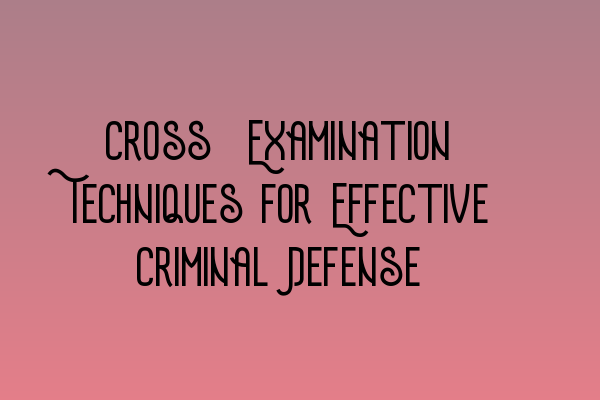Cross-Examination Techniques for Effective Criminal Defense
When it comes to criminal defense, cross-examination is a vital tool in your arsenal. It is the process of questioning a witness called by the prosecution during a trial. Properly conducted cross-examination can expose inconsistencies, raise doubt, and ultimately strengthen your client’s defense. In this article, we will delve into some effective cross-examination techniques that can help you achieve success in the courtroom.
1. Prepare Thoroughly
Preparation is the key to a successful cross-examination. Start by studying the witness statements, police reports, and any other relevant evidence in detail. Identify potential weaknesses or inconsistencies in their testimony. Use this information to formulate a strategy and craft your questions effectively.
It is also important to familiarize yourself with the rules of cross-examination in your jurisdiction. Understand the limitations and guidelines to ensure you conduct yourself professionally and within the prescribed boundaries.
2. Control the Narrative
During cross-examination, you have the opportunity to shape the narrative to benefit your client. Start by asking open-ended questions that require the witness to provide detailed responses. This allows you to control the direction of the testimony and steer it towards favorable aspects of your client’s defense.
Additionally, framing questions in a way that elicits yes or no answers can be useful in trapping the witness into admissions that contradict their previous statements. By controlling the narrative, you can create doubt and undermine the credibility of the witness.
3. Use Leading Questions
Leading questions are an essential tool in cross-examination. These are questions that suggest answers or provide information to the witness. By using leading questions, you maintain control of the testimony and direct it to support your client’s defense strategy.
For example, instead of asking, “Can you tell us what you saw on the night of the incident?” you could ask, “Isn’t it true that you saw my client at a different location during the time of the alleged crime?” This style of questioning allows you to guide the witness towards the version of events that benefits your defense.
4. Impeach the Witness
Impeaching a witness means attacking their credibility or disputing their testimony. This can be done by uncovering any inconsistencies, contradictions, or biases in their statements. Use prior statements, testimonies, or even video evidence to challenge their reliability.
When impeaching a witness, be prepared with specific examples and evidence to support your claims. Point out any discrepancies and confront the witness with the contradictions. This can significantly weaken the prosecution’s case and strengthen your defense.
5. Listen Carefully
While cross-examining a witness, it is crucial to actively listen to their responses. Pay attention to their tone, body language, and subtle cues that may indicate dishonesty or uncertainty. Use this information to your advantage and follow up with probing questions.
By actively listening, you can spot inconsistencies in their testimony or uncover information that may work in your favor. This observation and quick thinking can be a game-changer during cross-examination.
Effective cross-examination is a skill that requires practice, experience, and a deep understanding of criminal law. By incorporating these techniques into your defense strategy, you can maximize your chances of achieving a successful outcome for your client.
If you would like to further enhance your legal skills and preparation for the SQE examinations, check out our related articles and courses:
